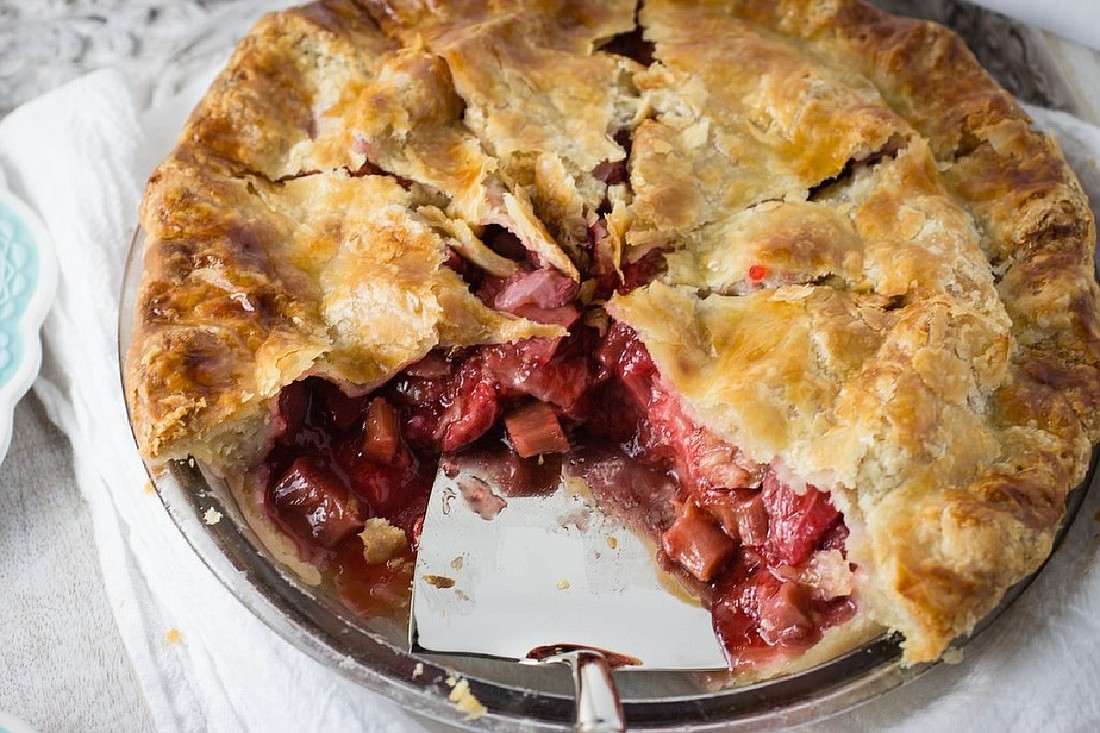In the Northwest, Rhubarb Means Summer
July 5, 2017 at 10:22 a.m. | Updated July 16, 2024 at 7:01 p.m.
What is this outrageous plant with leaves as big as elephant ears and ruby red stems that are sour beyond belief? Despite poisonous leaves, this plant has the nickname “pie plant.” This plant is rhubarb!
Find rhubarb in your neighborhood farmers’ market or grocery. The color of the rhubarb stalk may vary from deep red to speckled pink to pale green, but it is all good to eat. If you have an out-of-the-way corner of your garden, buy a piece of rhubarb root, stick it in the ground, fertilize it once a year, and water it once a week. You will be rewarded with a spring and summer supply every year.
Cook the stalks in a variety of ways. Stewed, they yield a tart sauce that can be eaten like applesauce, served over ice cream, or used as filling for pies, crisps or tarts. If rhubarb is a new food to you, try mixing it half-and-half with strawberries or apples. Rhubarb is good flavored with grated orange peel, ginger or cinnamon. It makes excellent jam. Try strawberry-rhubarb or blueberry-rhubarb. A half-cup serving is a low-potassium food. Here are some recipes to enjoy.
Rhubarb Chutney
Sweet and tart. Use like applesauce as a condiment with meats and poultry.
2 pounds fresh rhubarb, chopped
2 cups chopped onion
1-1/2 cups brown sugar
2 tsp. cinnamon
1 tsp. ground ginger
1-2 tsp. ground cloves
1 cup vinegar
Combine ingredients in large, heavy saucepan. Cook until thickened, stirring often (about 30 minutes). Refrigerate and use within a month or two, or pack into hot sterilized jars and cover with canning lids. Set aside to seal. Yield: 2 pints
Rhubarb Squares
1 cup all-purpose flour
3/4 cup oatmeal
1 teaspoon cinnamon
1 cup brown sugar
1/2 cup unsalted butter, melted
4 cups chopped rhubarb
1 cup granulated sugar
1 cup water
3 Tablespoons cornstarch
Preheat oven to 350 F. Mix flour, oatmeal, cinnamon and brown sugar together. Add melted butter and mix until crumbly. Press 2/3 of the mixture into 9” x 9” square pan. Cover with chopped, raw rhubarb. Combine sugar, water and cornstarch in a small saucepan; boil for one minute or until thickened and pour over rhubarb. Sprinkle remaining crumb mixture on top. Bake 1 hour at 350F. Cut into 12 squares.
Rhubarb Custard Pie
Make a two-crust pastry recipe using your favorite recipe.
Filling
3 eggs, beaten slightly
3 Tablespoons milk
4 cups pink rhubarb, cut up
2 cups sugar
1/4 cup flour
3/4 teaspoon nutmeg
1 Tablespoon butter
Preheat oven to 375 F. Mix together eggs and milk. Set aside. Microwave the rhubarb (fresh: 3 minutes, frozen: until soft). Add the rhubarb, sugar, flour and nutmeg. Combine the two mixtures and pour into prepared pastry. Dot with butter.
Moisten rim of bottom crust with water and then add the top crust. Press crusts together by pinching around the edge. Cut vent holes into the top crust. Place the pie pan on a cookie sheet covered with foil for easy cleanup. Bake at 375F for approximately 40 minutes.
The recipes in this column are meant for people who want to keep their kidney health by following a low sodium diet. These recipes can also be used by people who have stage 1-3 kidney disease, but they may be too high in phosphorus and potassium for some people with stage 4-5. In most cases, except for dialysis patients, a diet high in potassium is thought to help lower high blood pressure. These recipes are not intended for people on dialysis without the supervision of a registered dietitian.
The information in this column is meant for people who want to keep their kidneys healthy and blood pressure down by following a low-sodium diet. In most cases, except for dialysis patients, a diet high in potassium is thought to help lower high blood pressure. These recipes are not intended for people on dialysis without the supervision of a registered dietitian.
Katy G. Wilkens is a registered dietitian and department head at Northwest Kidney Centers. A recipient of the Susan Knapp Excellence in Education Award from the National Kidney Foundation Council on Renal Nutrition, she has a Master of Science degree in nutritional sciences from the University of Washington. See more of her recipes at www.nwkidney.org.





